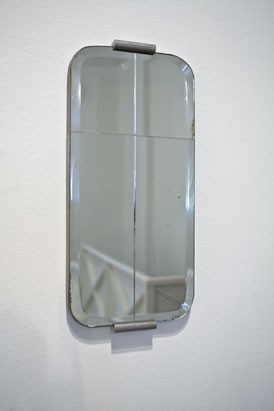Robin Collyer
Didier Courbot
Brian Groombridge
Patrick Howlett
Axel Lieber
organized by Jen Hutton
8 July to 21 August 2010

Axel Lieber: short cuts (mirror), 2007
On the outside, the façade of Susan Hobbs Gallery is pretty unremarkable: a cinder block building that was constructed in 1957 to house a commercial salvage business for used barrels and drums. Since 1993, it continues to be a site for commodity exchange, albeit a special one. Its renovated interior maintains its anonymity as a standard white cube, but everyday experience reveals the particularities of this gallery space, from the inconvenient staircase to the errant holes in the floor, a registered record of its past lives and previous use.
Though the premise of Site Exercises might provoke a charge of blatant navel gazing, the site and architectural details of Susan Hobbs Gallery become a starting point for further conversations. Indeed, site-specificity has become a ubiquitous art form, though not commonplace in commercial settings. Historically, the genre has known to be strictly “anti-commercial,” giving way to land art, earthworks or actions characterized as institutional critique, but in its purest form, it investigates and isolates the concrete, qualifiable elements of a site. As host, a white-walled gallery space seems equally ubiquitous, but by default it can be both a tabula rasa and a subject that permits presentations of works together in an open format. Especially in the context of a group show, the gallery becomes an arena for spatial (or political) negotiations. Whether they are invasive or reflective, Site Exercises focuses on those possibilities and impossibilities–of proposals that have not yet been realized or of physical feats–that skew the standard rules and conventions of display.
Brian Groombridge’s Untitled (2002) is the anchor for the exhibition, literally connecting the two floors of the gallery with a vertical “zip” threaded through a small existing hole in the floor. Mirroring its form isVertical, a precarious new installation by Didier Courbot built from materials on hand in the gallery. As well, Courbot’s ongoing explorations of the aleatoric are also shown in a selection of sketches from 2004 to the present of proposed site-specific projects for Susan’s gallery. Nearby, a cluster of wall works by Ian Carr-Harris, Patrick Howlett and Axel Lieber make formal associations to each other and their adjacent neighbours while referring to sites of the past and present in different ways. Like Groombridge’s reference to a former location, Carr-Harris’ America (2007) is a distorted representation of another, external site, while Lieber’s short cuts (mirror), a found object bisected and condensed into its essential parts, is an “unbiased” object that passively reflects the space around it. On the opposite wall, Robin Collyer’s Styrofoam installation Factory (2000), a sprawling abstraction of an industrial site that mimics the austere architectural details of the gallery space, is memorialized at its site of installation.
On the second floor, Howlett’s intimate watercolour compositions are abstractions of “in-between” words: prepositions and conjunctions extracted from a review of a Luc Tuymans exhibition. Painted directly on the wall, its and on (both 2010) punctuate the white space of the gallery, just as they fill the interstitial spaces in the body of a text.

